sensor TOYOTA TUNDRA 2020 Owners Manual (in English)
[x] Cancel search | Manufacturer: TOYOTA, Model Year: 2020, Model line: TUNDRA, Model: TOYOTA TUNDRA 2020Pages: 52, PDF Size: 3.85 MB
Page 3 of 52
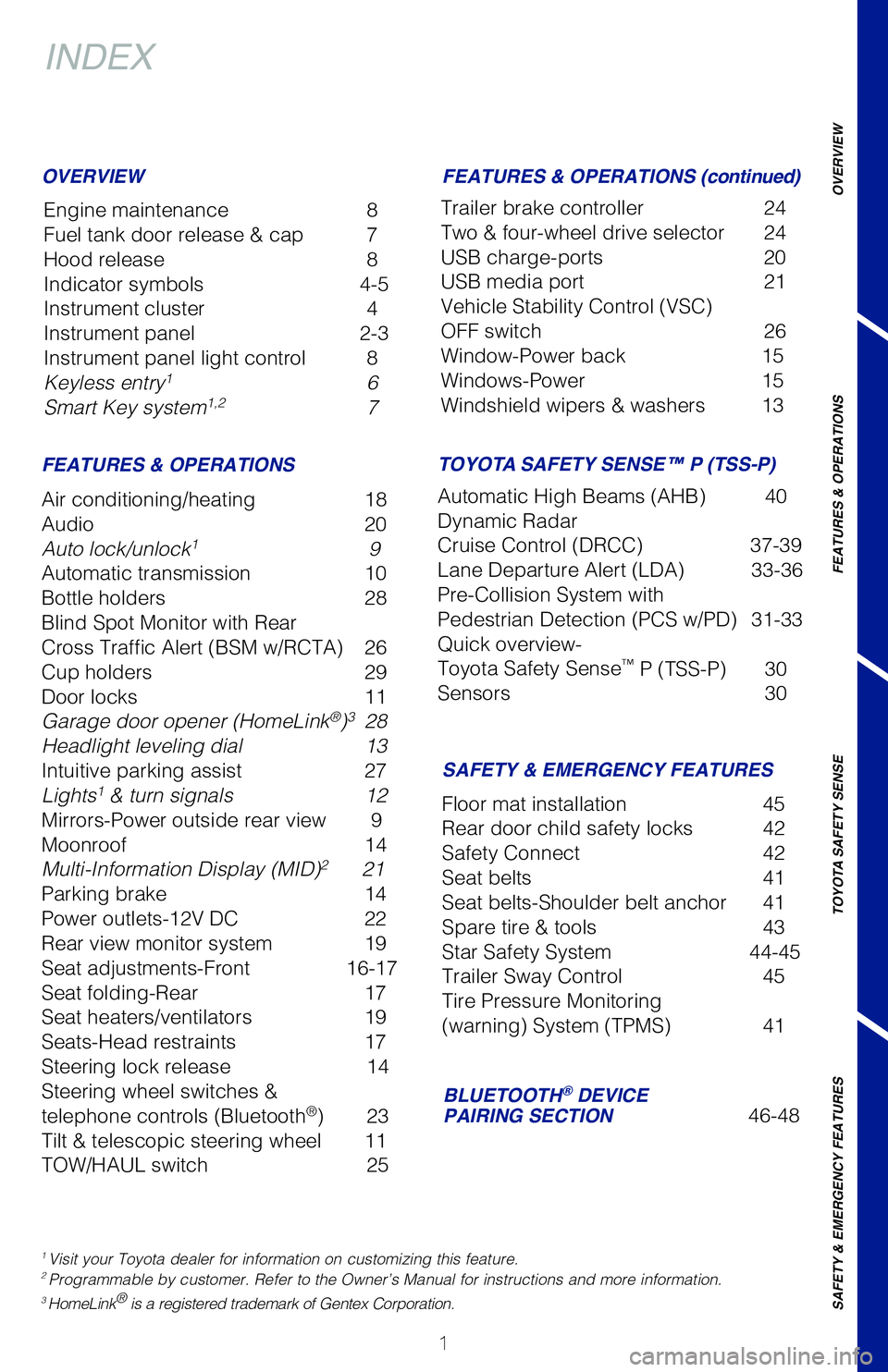
1
OVERVIEW
FEATURES & OPERATIONS
TOYOTA SAFETY SENSE
SAFETY & EMERGENCY FEATURES
INDEX
Engine maintenance 8
Fuel tank door release & cap 7
Hood release 8
Indicator symbols 4-5
Instrument cluster 4
Instrument panel 2-3
Instrument panel light control 8
Keyless entry1 6
Smart Key system1,2 7
OVERVIEW
FEATURES & OPERATIONS
FEATURES & OPERATIONS (continued)
SAFETY & EMERGENCY FEATURES
Air conditioning/heating 18
Audio 20
Auto lock/unlock1 9
Automatic transmission 10
Bottle holders 28
Blind Spot Monitor with Rear
Cross Traffic Alert (BSM w/RCTA) 26
Cup holders 29
Door locks 11
Garage door opener (HomeLink®)3 28
Headlight leveling dial 13
Intuitive parking assist 27
Lights1 & turn signals 12
Mirrors-Power outside rear view 9
Moonroof 14
Multi-Information Display (MID)2 21
Parking brake 14
Power outlets-12V DC 22
Rear view monitor system 19
Seat adjustments-Front 16-17
Seat folding-Rear 17
Seat heaters/ventilators 19
Seats-Head restraints 17
Steering lock release 14
Steering wheel switches &
telephone controls (Bluetooth®) 23
Tilt & telescopic steering wheel 11
TOW/HAUL switch 25
Trailer brake controller 24
Two & four-wheel drive selector 24
USB charge-ports 20
USB media port 21
Vehicle Stability Control (VSC)
OFF switch 26
Window-Power back 15
Windows-Power 15
Windshield wipers & washers 13
Floor mat installation 45
Rear door child safety locks 42
Safety Connect 42
Seat belts 41
Seat belts-Shoulder belt anchor 41
Spare tire & tools 43
Star Safety System 44-45
Trailer Sway Control 45
Tire Pressure Monitoring
(warning) System (TPMS) 41
BLUETOOTH® DEVICE PAIRING SECTION 46-48
1 Visit your Toyota dealer for information on customizing this feature.2 Programmable by customer. Refer to the Owner’s Manual for instructions and more information.3 HomeLink® is a registered trademark of Gentex Corporation.
TOYOTA SAFETY SENSE™ P (TSS-P)
Automatic High Beams (AHB) 40
Dynamic Radar
Cruise Control (DRCC) 37-39
Lane Departure Alert (LDA) 33-36
Pre-Collision System with
Pedestrian Detection (PCS w/PD) 31-33
Quick overview-
Toyota Safety Sense™ P (TSS-P) 30
Sensors 30
Page 28 of 52
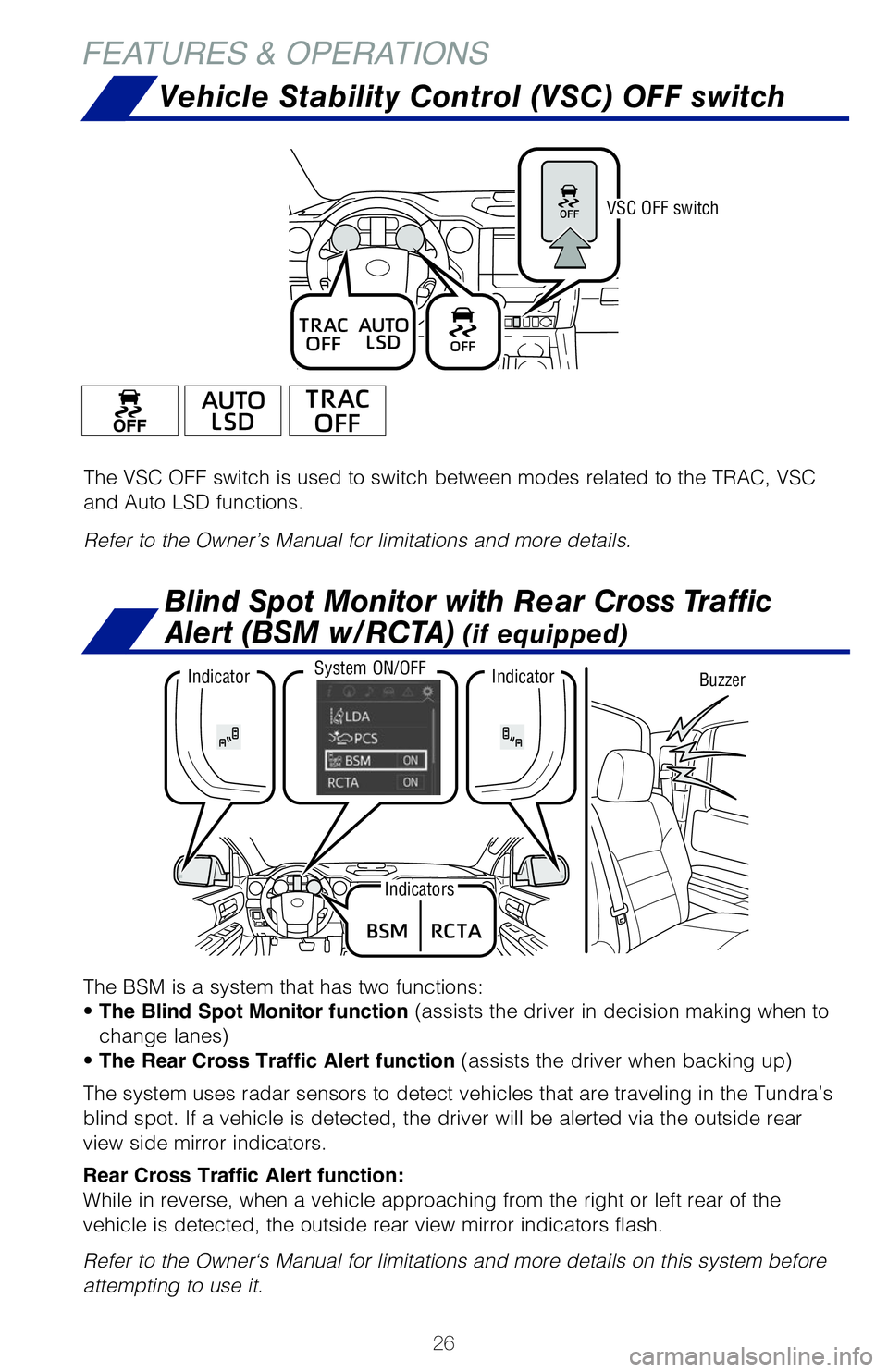
26
Vehicle Stability Control (VSC) OFF switch
FEATURES & OPERATIONS
The VSC OFF switch is used to switch between modes related to the TRAC, VSC
and Auto LSD functions.
Refer to the Owner’s Manual for limitations and more details.
VSC OFF switch
The BSM is a system that has two functions:
• The Blind Spot Monitor function (assists the driver in decision making when to
change lanes)
• The Rear Cross Traffic Alert function (assists the driver when backing up)
The system uses radar sensors to detect vehicles that are traveling in the Tundra’s
blind spot. If a vehicle is detected, the driver will be alerted via the outside rear
view side mirror indicators.
Rear Cross Traffic Alert function:
While in reverse, when a vehicle approaching from the right or left rear of the
vehicle is detected, the outside rear view mirror indicators flash.
Refer to the Owner‘s Manual for limitations and more details on this system before
attempting to use it.
BuzzerSystem ON/OFFIndicatorIndicator
Indicators
Blind Spot Monitor with Rear Cross Traffic
Alert (BSM w/RCTA) (if equipped)
Page 29 of 52
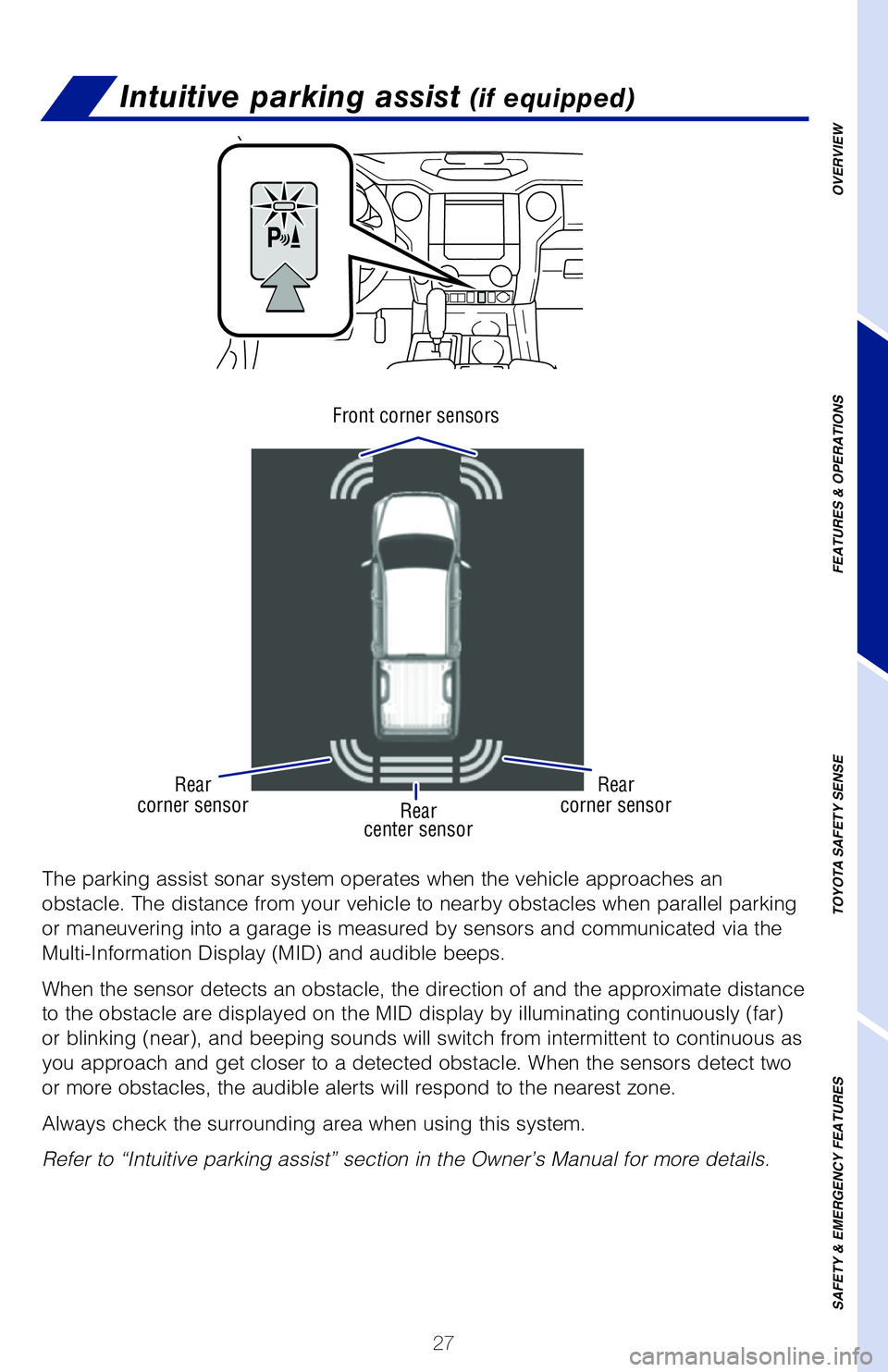
27
Intuitive parking assist (if equipped)
The parking assist sonar system operates when the vehicle approaches an
obstacle. The distance from your vehicle to nearby obstacles when parallel parking
or maneuvering into a garage is measured by sensors and communicated via the
Multi-Information Display (MID) and audible beeps.
When the sensor detects an obstacle, the direction of and the approximate distance
to the obstacle are displayed on the MID display by illuminating continuously (far)
or blinking (near), and beeping sounds will switch from intermittent to continuous as
you approach and get closer to a detected obstacle. When the sensors detect two
or more obstacles, the audible alerts will respond to the nearest zone.
Always check the surrounding area when using this system.
Refer to “Intuitive parking assist” section in the Owner’s Manual for more details.
Rearcenter sensor
Front corner sensors
Rear corner sensorRear corner sensor
OVERVIEW
FEATURES & OPERATIONS
TOYOTA SAFETY SENSE
SAFETY & EMERGENCY FEATURES
Page 32 of 52
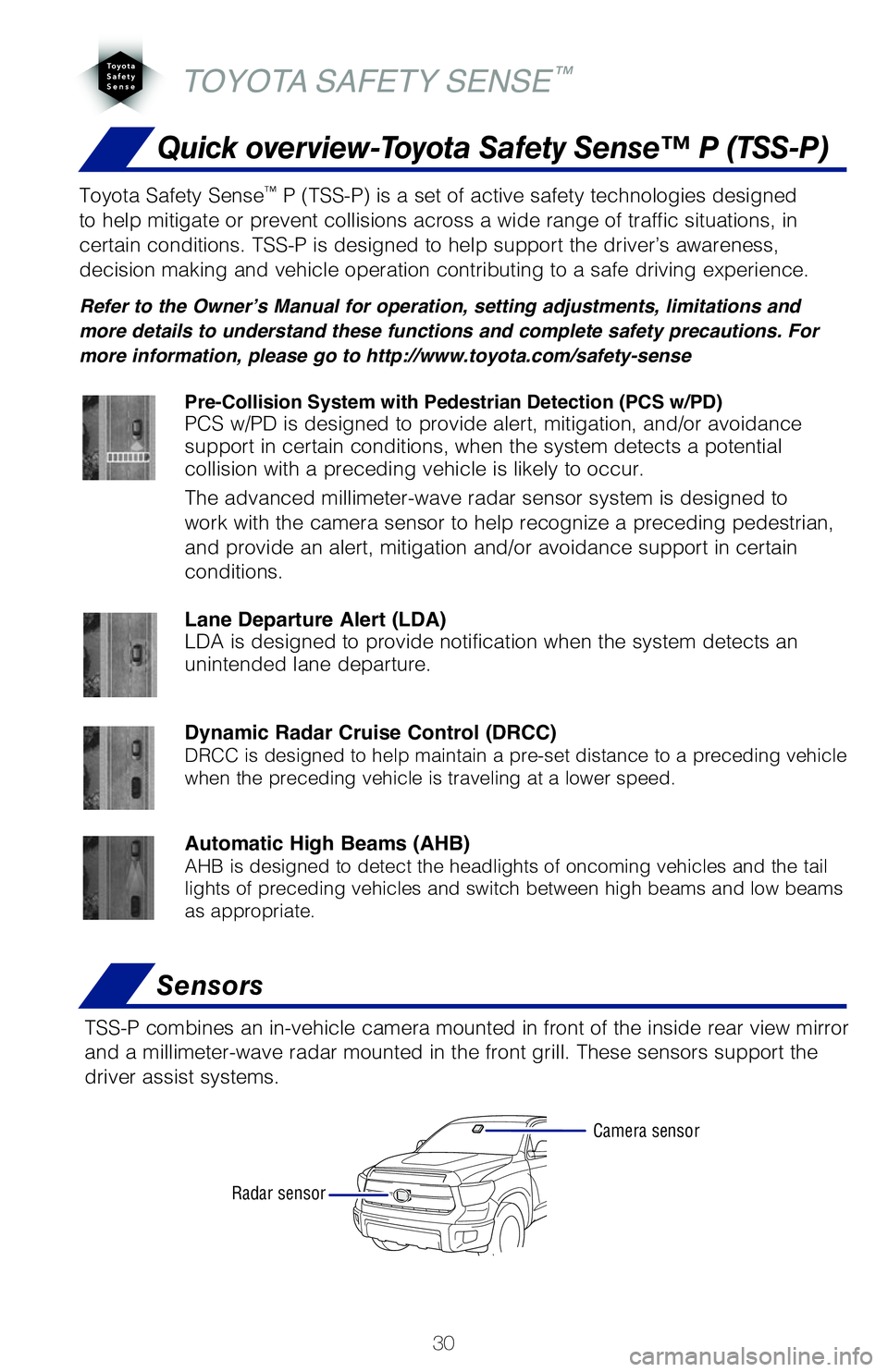
30
Quick overview-Toyota Safety Sense™ P (TSS-P)
Sensors
TSS-P combines an in-vehicle camera mounted in front of the inside rear view mirror
and a millimeter-wave radar mounted in the front grill. These sensors support the
driver assist systems.
TOYOTA SAFETY SENSE™
Toyota Safety Sense™ P (TSS-P) is a set of active safety technologies designed
to help mitigate or prevent collisions across a wide range of traffic situations, in
certain conditions. TSS-P is designed to help support the driver’s awareness,
decision making and vehicle operation contributing to a safe driving experience.
Refer to the Owner’s Manual for operation, setting adjustments, limitations and
more details to understand these functions and complete safety precautions. For
more information, please go to http://www.toyota.com/safety-sense
Automatic High Beams (AHB)AHB is designed to detect the headlights of oncoming vehicles and the tail lights of preceding vehicles and switch between high beams and low beams as appropriate.
Pre-Collision System with Pedestrian Detection (PCS w/PD)
PCS w/PD is designed to provide alert, mitigation, and/or avoidance support in certain conditions, when the system detects a potential collision with a preceding vehicle is likely to occur.
The advanced millimeter-wave radar sensor system is designed to
work with the camera sensor to help recognize a preceding pedestrian,
and provide an alert, mitigation and/or avoidance support in certain
conditions.
Dynamic Radar Cruise Control (DRCC)
DRCC is designed to help maintain a pre-set distance to a preceding vehicle when the preceding vehicle is traveling at a lower speed.
Lane Departure Alert (LDA) LDA is designed to provide notification when the system detects an unintended lane departure.
Camera sensor
Radar sensor
Page 33 of 52
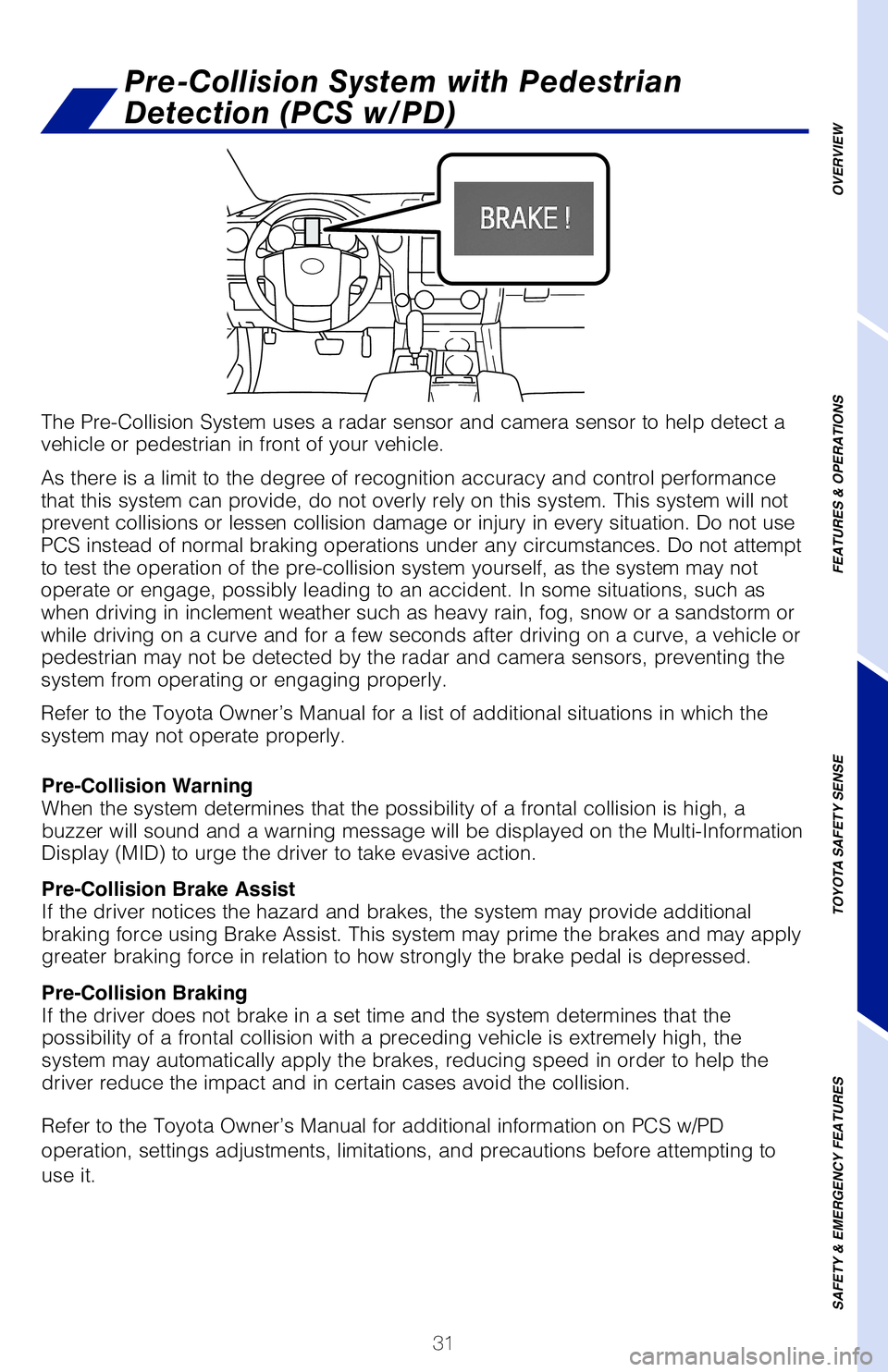
31
The Pre-Collision System uses a radar sensor and camera sensor to help detect a vehicle or pedestrian in front of your vehicle.
As there is a limit to the degree of recognition accuracy and control performance that this system can provide, do not overly rely on this system. This system will not prevent collisions or lessen collision damage or injury in every situation. Do not use PCS instead of normal braking operations under any circumstances. Do not attempt to test the operation of the pre-collision system yourself, as the system may not operate or engage, possibly leading to an accident. In some situations, such as when driving in inclement weather such as heavy rain, fog, snow or a sandstorm or while driving on a curve and for a few seconds after driving on a curve, a vehicle or pedestrian may not be detected by the radar and camera sensors, preventing the system from operating or engaging properly.
Refer to the Toyota Owner’s Manual for a list of additional situations in which the system may not operate properly.
Refer to the Toyota Owner’s Manual for additional information on PCS w/PD
operation, settings adjustments, limitations, and precautions before attempting to
use it.
Pre-Collision Warning When the system determines that the possibility of a frontal collision is high, a buzzer will sound and a warning message will be displayed on the Multi-Information Display (MID) to urge the driver to take evasive action.
Pre-Collision Brake Assist If the driver notices the hazard and brakes, the system may provide additional braking force using Brake Assist. This system may prime the brakes and may apply greater braking force in relation to how strongly the brake pedal is depressed.
Pre-Collision Braking If the driver does not brake in a set time and the system determines that the possibility of a frontal collision with a preceding vehicle is extremely high, the system may automatically apply the brakes, reducing speed in order to help the driver reduce the impact and in certain cases avoid the collision.
Pre-Collision System with Pedestrian
Detection (PCS w/PD)
OVERVIEW
FEATURES & OPERATIONS
TOYOTA SAFETY SENSE
SAFETY & EMERGENCY FEATURES
Page 34 of 52
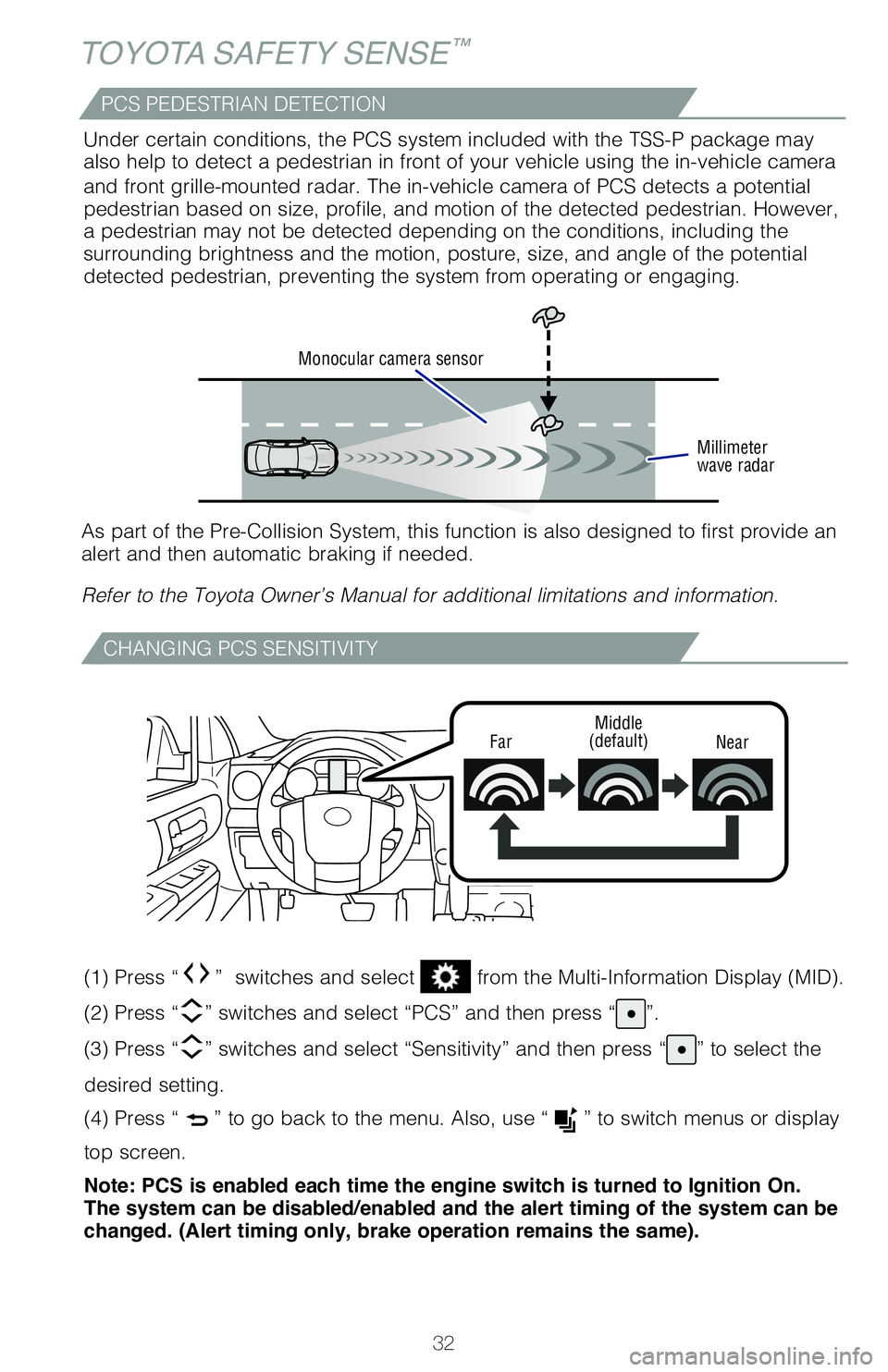
32
TOYOTA SAFETY SENSE™
CHANGING PCS SENSITIVITY
FarMiddle(default)Near
(1) Press “” switches and select from the Multi-Information Display (MID).
(2) Press “” switches and select “PCS” and then press “”.
(3) Press “” switches and select “Sensitivity” and then press “” to select the
desired setting.
(4) Press “” to go back to the menu. Also, use “” to switch menus or display
top screen.
Note: PCS is enabled each time the engine switch is turned to Ignition On. The system can be disabled/enabled and the alert timing of the system can be changed. (Alert timing only, brake operation remains the same).
Monocular camera sensor
Millimeter wave radar
As part of the Pre-Collision System, this function is also designed to first provide an alert and then automatic braking if needed.
Refer to the Toyota Owner’s Manual for additional limitations and information.
Under certain conditions, the PCS system included with the TSS-P package may also help to detect a pedestrian in front of your vehicle using the in-vehicle camera
and front grille-mounted radar. The in-vehicle camera of PCS detects a potential pedestrian based on size, profile, and motion of the detected pedestrian. However, a pedestrian may not be detected depending on the conditions, including the surrounding brightness and the motion, posture, size, and angle of the potential detected pedestrian, preventing the system from operating or engaging.
PCS PEDESTRIAN DETECTION
Page 40 of 52
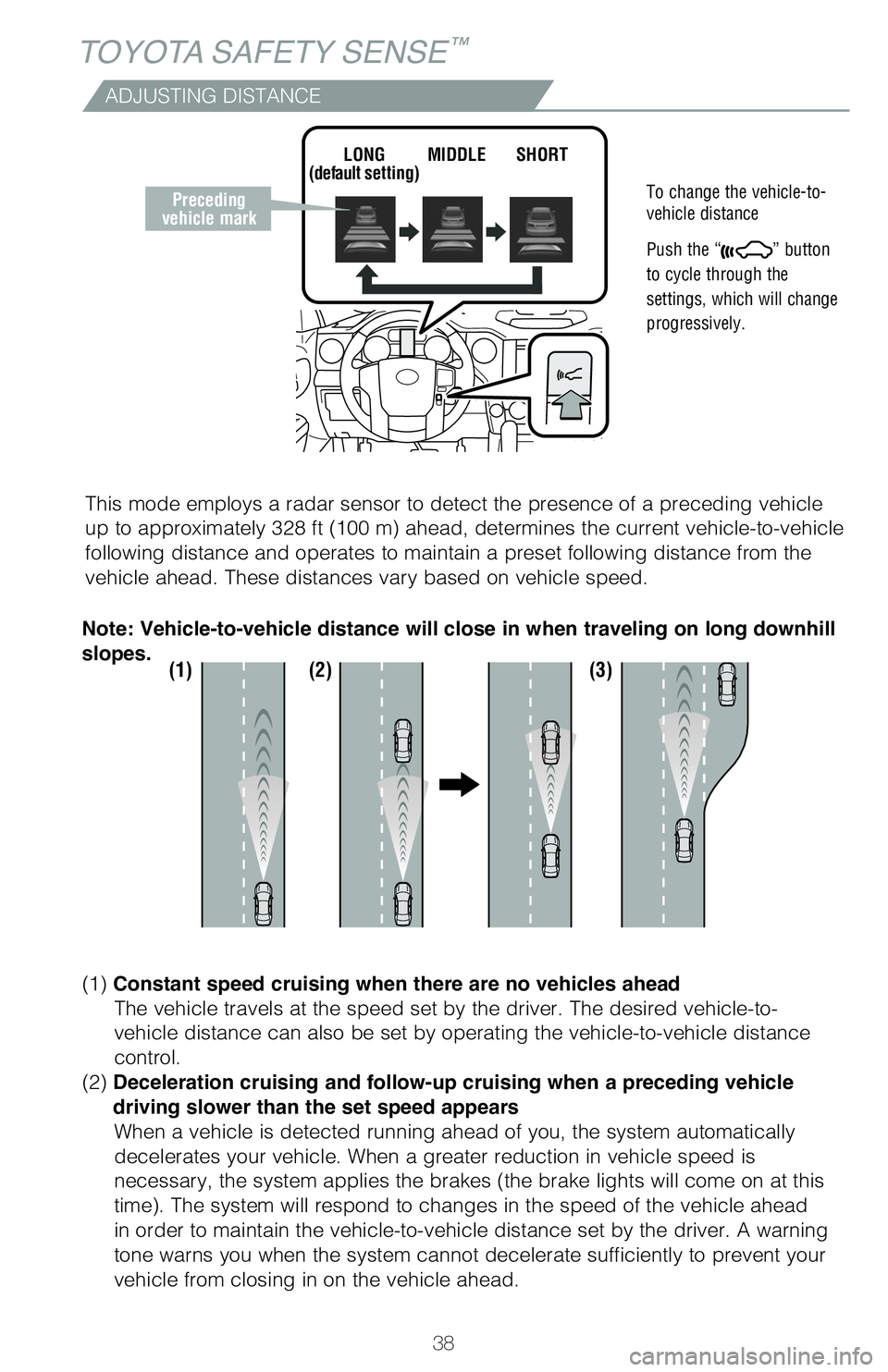
38
TOYOTA SAFETY SENSE™
ADJUSTING DISTANCE
To change the vehicle-to- vehicle distance
Push the “” button
to cycle through the
settings, which will change
progressively.
This mode employs a radar sensor to detect the presence of a preceding vehicle
up to approximately 328 ft (100 m) ahead, determines the current vehicle-to-vehicle
following distance and operates to maintain a preset following distance from the
vehicle ahead. These distances vary based on vehicle speed.
(1) (2) (3)
(1) Constant speed cruising when there are no vehicles ahead
The vehicle travels at the speed set by the driver. The desired vehicle-to-
vehicle distance can also be set by operating the vehicle-to-vehicle distance
control.
(2) Deceleration cruising and follow-up cruising when a preceding vehicle
driving slower than the set speed appears
When a vehicle is detected running ahead of you, the system automatically
decelerates your vehicle. When a greater reduction in vehicle speed is
necessary, the system applies the brakes (the brake lights will come on at this
time). The system will respond to changes in the speed of the vehicle ahead
in order to maintain the vehicle-to-vehicle distance set by the driver. A warning
tone warns you when the system cannot decelerate sufficiently to prevent your
vehicle from closing in on the vehicle ahead.
Note: Vehicle-to-vehicle distance will close in when traveling on long downhill
slopes.
Preceding vehicle mark
LONG(default setting)MIDDLE SHORT
Page 46 of 52
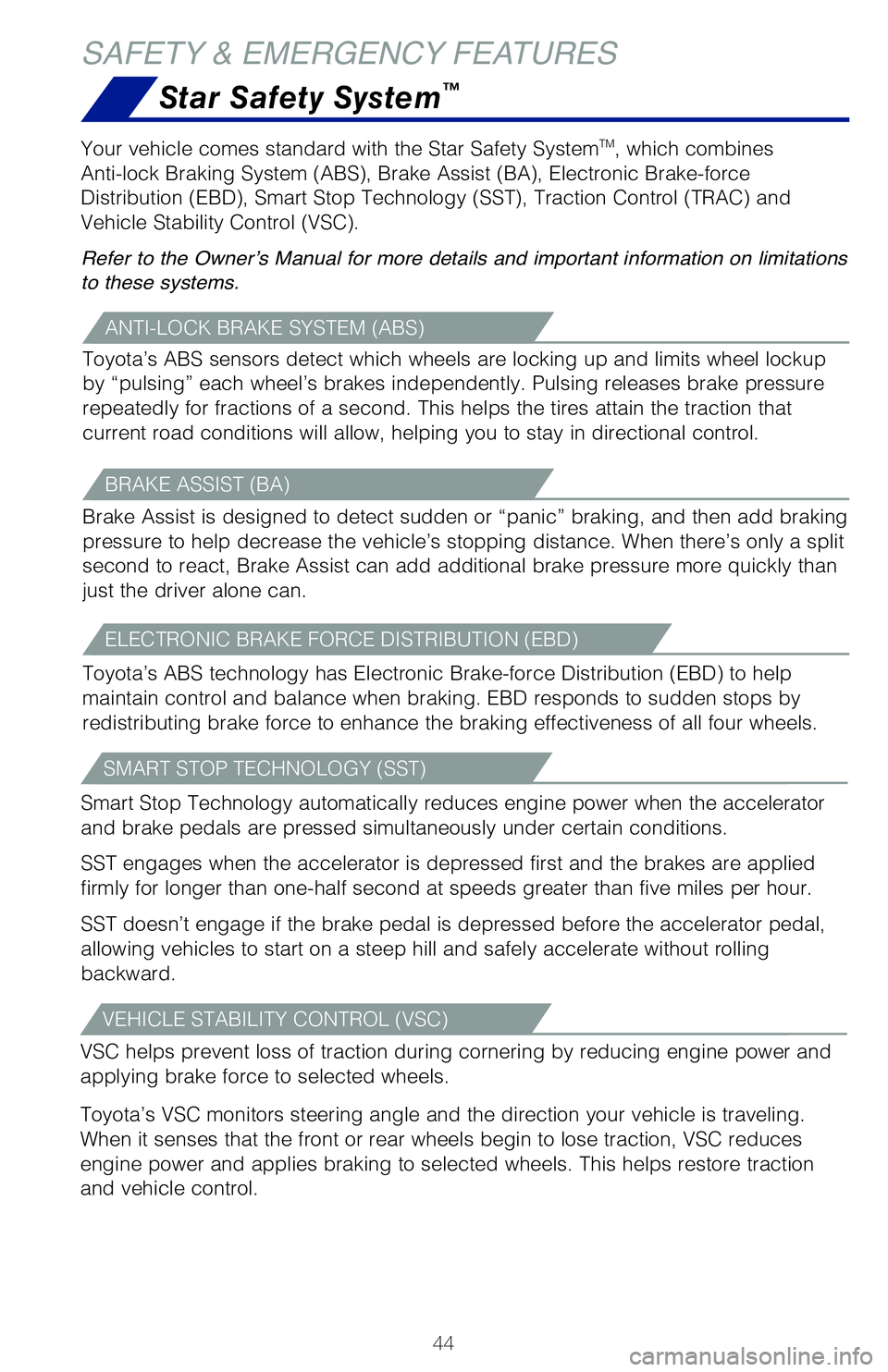
44
SAFETY & EMERGENCY FEATURES
Star Safety System™
ANTI-LOCK BRAKE SYSTEM (ABS)
Toyota’s ABS sensors detect which wheels are locking up and limits wheel lockup
by “pulsing” each wheel’s brakes independently. Pulsing releases brake pressure
repeatedly for fractions of a second. This helps the tires attain the traction that
current road conditions will allow, helping you to stay in directional control.
BRAKE ASSIST (BA)
Brake Assist is designed to detect sudden or “panic” braking, and then add braking
pressure to help decrease the vehicle’s stopping distance. When there’s only a split
second to react, Brake Assist can add additional brake pressure more quickly than
just the driver alone can.
ELECTRONIC BRAKE FORCE DISTRIBUTION (EBD)
Toyota’s ABS technology has Electronic Brake-force Distribution (EBD) to help
maintain control and balance when braking. EBD responds to sudden stops by
redistributing brake force to enhance the braking effectiveness of all four wheels.
Your vehicle comes standard with the Star Safety SystemTM, which combines
Anti-lock Braking System (ABS), Brake Assist (BA), Electronic Brake-force
Distribution (EBD), Smart Stop Technology (SST), Traction Control (TRAC) and
Vehicle Stability Control (VSC).
Refer to the Owner’s Manual for more details and important information on limitations
to these systems.
SMART STOP TECHNOLOGY (SST)
Smart Stop Technology automatically reduces engine power when the accelerator
and brake pedals are pressed simultaneously under certain conditions.
SST engages when the accelerator is depressed first and the brakes are applied
firmly for longer than one-half second at speeds greater than five miles per hour.
SST doesn’t engage if the brake pedal is depressed before the accelerator pedal,
allowing vehicles to start on a steep hill and safely accelerate without rolling
backward.
VEHICLE STABILITY CONTROL (VSC)
VSC helps prevent loss of traction during cornering by reducing engine power and
applying brake force to selected wheels.
Toyota’s VSC monitors steering angle and the direction your vehicle is traveling.
When it senses that the front or rear wheels begin to lose traction, VSC reduces
engine power and applies braking to selected wheels. This helps restore traction
and vehicle control.
Page 47 of 52
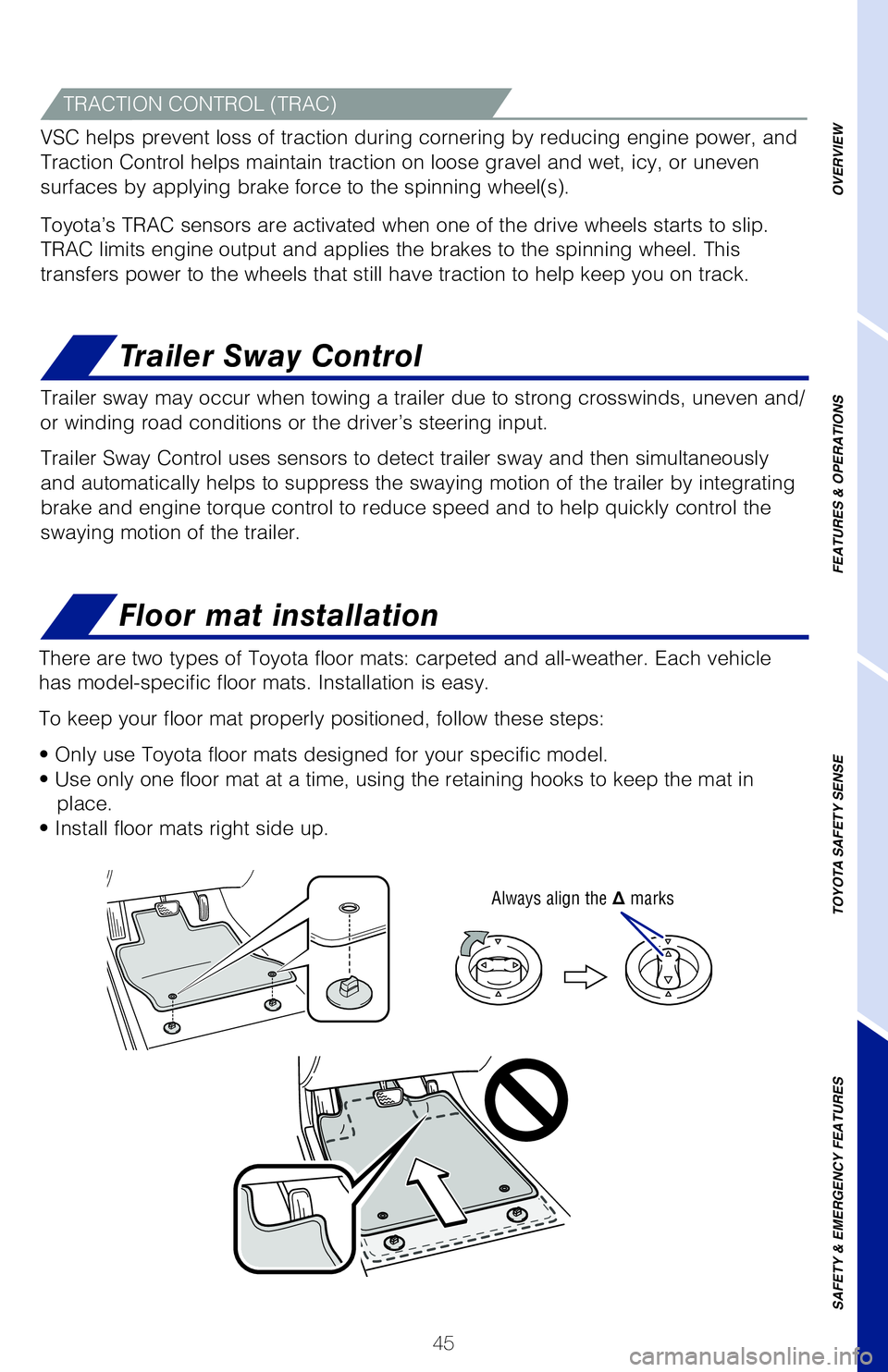
45
Floor mat installation
Trailer Sway Control
There are two types of Toyota floor mats: carpeted and all-weather. Each vehicle
has model-specific floor mats. Installation is easy.
To keep your floor mat properly positioned, follow these steps:
• Only use Toyota floor mats designed for your specific model.
• Use only one floor mat at a time, using the retaining hooks to keep the mat in
place.
• Install floor mats right side up.
Always align the marks
Trailer sway may occur when towing a trailer due to strong crosswinds, uneven and/
or winding road conditions or the driver’s steering input.
Trailer Sway Control uses sensors to detect trailer sway and then simultaneously
and automatically helps to suppress the swaying motion of the trailer by integrating
brake and engine torque control to reduce speed and to help quickly control the
swaying motion of the trailer.
TRACTION CONTROL (TRAC)
VSC helps prevent loss of traction during cornering by reducing engine power, and
Traction Control helps maintain traction on loose gravel and wet, icy, or uneven
surfaces by applying brake force to the spinning wheel(s).
Toyota’s TRAC sensors are activated when one of the drive wheels starts to slip.
TRAC limits engine output and applies the brakes to the spinning wheel. This
transfers power to the wheels that still have traction to help keep you on track.
OVERVIEW
FEATURES & OPERATIONS
TOYOTA SAFETY SENSE
SAFETY & EMERGENCY FEATURES